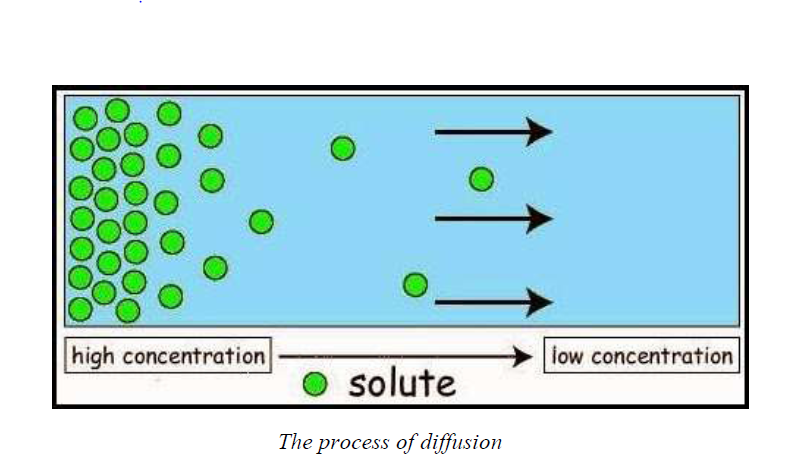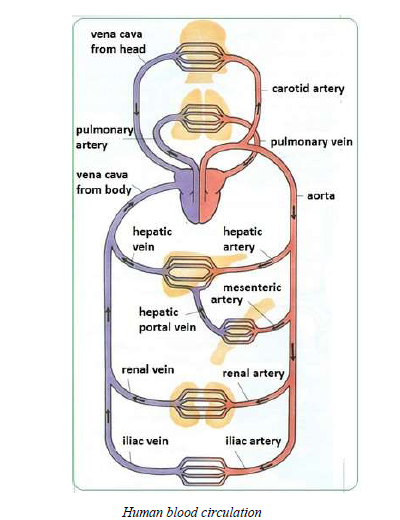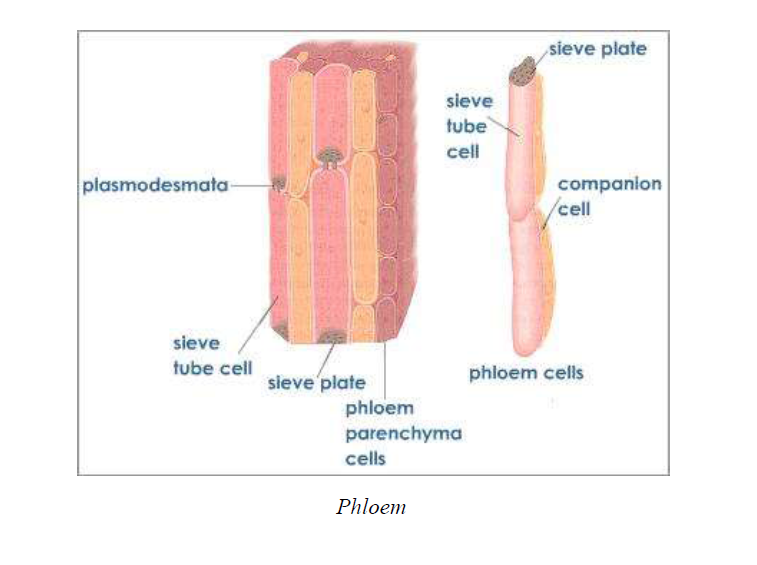Diffusion, Osmosis and Mass- flow



Transport of Materials in Mammals, the Structure of the Mammalian Heart




The Blood


Blood Groups and Blood Transfusion

Blood Circulation

The Lymphatics System
The Concept of Lymphatics
Explain the concept of lymphatics
The lymphatic system is a network of tissues and organs that primarily consists of lymph vessels, lymph nodes and lymph. The tonsils, adenoids, spleen and thymus are all part of the lymphatic system.
There are 600 to 700 lymph nodes in the human body that filter the lymph before it returns to thecirculatory system.
The spleen, which is the largest lymphatic organ, is located on the left side of the body just above the kidney.
The thymus, which stores immature lymphocytes and prepares them to become active T cells, islocated in the chest just above the heart.
Tonsils are large clusters of lymphatic cells found in the pharynx.
The Components of the Human Lymphatic System
Describe the components of the human lymphatic system
The Human Lymphatic System

Functions of the lymphatic system
The lymphatic system performs the following functions:
- Removes excess fluid and waste products from the interstitial spaces between the cells and returns it into the bloodstream.
- It also functions in transporting white blood cells to and from the lymph nodes into the bones, and antigen-presenting cells (APCs), such as dendritic cells, to the lymph nodes where an immune response is stimulated.
- Special lymph vessels (lacteals) absorb fat and fat-soluble vitamins from the small intestine and deliver these nutrients to the cells of the body where they are used by the cells.
- Protects the body against germs. Lymph glands produce lymphocytes which produce antibodies that fight against microbes. They also contain phagocytes, which eat dead white cells and microbes in the lymph.
The Common Disorders and Diseases of the Lymphatic System
Mention the common disorders and diseases of the lymphatic system
There are several diseases and disorders that affect the lymphatic system. The two common disorders of the lymphatic system are lymphoedema and lymphatic filariasis (elephantiasis).
Lymphoedema
Lymphoedema is a chronic swelling of the limbs caused by the accumulation of lymph fluid that occurs if the lymphatic system is damaged or not functioning properly. While the limbs are typically involved, the face, neck and abdomen may also be affected.
The lymphatic system consists of a series of lymph nodes (glands) connected by a network of vessels, similar to blood vessels. Fluid surrounding body tissues usually drains into near by lymph vessels so it can be transported back into the blood. However, if the lymph vessels are blocked, the fluid can't be reabsorbed and will build up in the tissue.
Symptoms
Swelling of the limbs (arms or legs) is the common symptom of this disorder.
Effects
Unlike oedema, lymphoedema is a long-term condition that can cause discomfort, pain and a loss of mobility.
Elephantiasis
Lymphatic filariasis, commonly known as elephantiasis, is a parasitic infection that causes extreme swelling in the arms and legs. It is a painful and profoundly disfiguring disease. While the infection is usually acquired in childhood, its visible manifestations occur later in life, causing temporary or permanent disability.
The disease is caused by the filarial worm, which is transmitted form human to human via thefemale mosquito when it takes a blood meal. The parasite grows into an adult worm that lives inthe lymphatic system of humans.
Symptoms
Elephantiasis is typically characterized by a thickening of the skin and subcutaneous tissue that gives rise to the grossly enlarged and swollen limbs that earn the condition its name. In addition to the characteristic swelling, people with this disorder sometimes have bouts of fever and headache.
Cause
The disease is caused by thread-like nematode worms, known as filariae. The larvae(microfilariae) of the parasite are taken up by the mosquito when it feeds. When the larvae reachthe third stage of development, they are introduced to a new host, who then develops theinfection.
Effects
- Filarial infection can cause lymphoedema of the limbs, genital disease (hydrocele, chylocele,and swelling of the scrotum and penis). It also causes recurrent acute attacks, which are extremely painf ul and are accompanied by fever.
- The infected people may have lymphatic and kidney damages.
- Sometimes the swollen limbs become infected.
- The infected person is disabled and cannot work to earn his/her living.
Causes, Symptoms, Effects and Prevention of Disorders and Diseases of the Human Lymphatic System
Explain causes, symptoms, effects and prevention of disorders and diseases of the human lymphatic system
Prevention and control
Effective treatment and preventive efforts would include:
- spraying insecticides to kill mosquitoes;
- giving antibiotics to prevent or control infection;
- giving medications to kill micro filariae circulating in the blood;
- applying pressure bandages to reduce swelling; and
- surgically removing infected tissue.
Transport of Material in Plants in Plants, the Vascular System
The Concept of Vascular System
Explain the concept of vascular system
TRANSPORTATION IN PLANTS
Materials to be transported across the plant body are water, minerals and food. Apart from these nutrients, substances like the hormones also have to be transported. The transport of materials takes place through a specialized tissue called the vascular tissue. The tissue is made up of xylem and phloem tissues. Xylem tissue transports water and mineral salts from the soil to all parts of the plant. Phloem tissue transports manufactured food from the sites of photosynthesis to all parts of the plant.
In between the xylem and phloem is the vascular cambium. The cells of cambium tissue divideto form a new xylem and phloem. As these cells divide and multiply, the plant increases its girth.The xylem grows inward from the vascular cambium while the phloem grows outward from thevascular cambium.
The arrangement of the vascular bundles in the stem, root and leaf of dicot and mocot plants differs in a number of ways. The diagrams below show the manner they are arranged in there spective organs.
The vascular tissue in the root is arranged in the inner portion of the root, which is called the vascular cylinder. A layer of cells known as the endodermis separates the vascular tissue from the ground tissue in the outer portion of the root. The endodermis is exclusive to roots, and serves as a checkpoint for materials entering the root’s vascular system. A waxy substance called suber in is present on the walls of the endodermal cells. This waxy region, known as the Casparian strip, forces water and solutes to cross the plasma membranes of endodermal cells instead of slipping between the cells. This ensures that only materials required by the root passthrough the endodermis, while toxic substances and pathogens are generally excluded. The outermost cell layer of the root’s vascular tissue is the pericycle, an area that can give rise to lateral roots. In dicot roots, the xylem and phloem are arranged alternately in an X shape, whereas in monocot roots, the vascular tissue is arranged in a ring around the pith.In

In monocot stems, the vascular bundles are scattered throughout the stem as indicated in the figure below.

In dicot stems, the vascular bundles are arranged in a ring around the pith.

The arrangement of vascular bundles in the leaves of dicots and monocots differs. The diagrams below show the differences in arrangement of the bundles. Can you notice the differences? The xylem and phloem vessels are enclosed in a bundle sheath.


Components of Vascular System
Describe components of vascular system
The vascular (transport) system in plants is made of vascular bundles. The vascular bundles are made of xylem and phloem which are separated by a wall called vascular cambium, often simply shortened as cambium (see diagrams discussed in the previous section).
Xylem
It is the vascular tissue that transports water across the plant body. Xylem is made up of four different types of cells. They are tracheids, vessels, xylem fibres and xylem parenchyma. Of these only tracheids and vessels are involved in the transport of water and minerals.
Tracheids
Tracheids are elongated dead cells that have sloping end walls. The cavity is empty as the cellsare dead. The walls are thickened with a material called lignin to prevent them from collapsingas water is transported up the plant. These thickenings are in different patterns. The cells arearranged end to end.
Vessels
Vessels are also dead cells that have variously patterned thickened walls. These thickenings are due to lignin. The vessels are arranged end to end. The end walls of the vessels are either partially or fully dissolved. This results in the formation of long tubes that carry water.The xylem vessels and tracheids together form long tubes that have a narrow diameter. Thus they function as capillaries (narrow tubes) to transport water.

Phloem
It is the vascular tissue that transports organic substances like sucrose across the plant body. It is made up of four types of cells namely sieve tubes, companion cells, phloem fibres and phloem parenchyma. Except for phloem fibres, all the other three types of cells are living. Sieve tubes and companion cells are mainly involved in the transport of the materials.

Sieve tubes
They are tubes formed by cells that are joined end to end. The end walls of these cells have perforations. The mature sieve tube cells are enucleated. The cytoplasm of the sieve tube cells is continuous through the perforations of the end walls. This helps in the transport of materials.
Companion cells
They are smaller cells associated with the sieve tubes. They have dense cytoplasm and elongatednucleus. They are in contact with the sieve tube cell through pores in the wall.
The Function of Vascular System in Plants
Explain the function of vascular system in plants
The vascular system is mainly responsible for transportation of materials within a plant body.The xylem and phloem tissues are specialized to perform different functions in a plant body.
Functions ofphloem
The xylem functions in transport (translocation) of manufactured food from the leaves to the cells of the plant, storage organs, fruits, etc.
Functions ofxylem
- Provides support for woody plants.
- Transports water and solutes from roots to all plant parts.
Absorption and Movement of Water and Mineral Salts in Plants
The Functions of Root Hairs in Absorption and Movement of Water and Mineral Salts in Plants
Explain the functions of root hairs in absorption and movement of water and mineral salts in plants
Water and mineral uptake by roots
Plants absorb water from the soil through the root and transport it to the stem, leaves and flowers. Roots have root hairs that are unicellular, thin-walled outgrowths of the epiblema (skin of the root).
The root hairs are in close contact with the thin film of water surrounding the soil particles.There are mineral salts such as nitrates, chlorides, sulphates, phosphates, etc., dissolved in thiswater.
Water is absorbed by osmosis, while the minerals are absorbed as ions by active transport(transport against the law of diffusion, by spending cellular energy). The cell membrane hastransport proteins that allow the ions to cross the membrane. The ions then move upward throughthe xylem, to the leaves and other aerial parts of the plant.
The cell wall of each root hair is permeable to water and minerals, but its cell membrane and the membrane around the vacuole are semi permeable membranes. The root hair cells take up mineral ions by active transport.
This creates a concentration difference of these ions between the root and the soil. Now, the soil solution has higher water content than the cell sap of the root hair. Hence, water from the soil diffuses into the root hair. The root hair cells now become turgid, while the adjacent cells of the cortex have lower water content.
This results in the diffusion of water from the root hairs into the cortical cells (see figure below).After passing through the cortical cells by osmosis, the water reaches the endodermis (tissue separating the cortex from the vascular tissues). The endodermis forces water into the xylem tubes through passage cells.

The pressure with which water is pushed into the xylem tubes of the root is called root pressure.The water moving upwards forms a column, which is maintained up to a certain height due to root pressure.
The Movement of Water and Dissolved Mineral Salts in Plants
Outline the movement of water and dissolved mineral salts in plants
Upward movement of water within the plant
There are several processes that enable the water to move up a plant. These processes include root pressure, transpiration pull, cohesion, adhesion and capillarity.
Root pressure
As long as the soil is damp, there will be water taken in by the root hairs. As more water is taken in, the water that is already in the xylem vessel will be pushed up the plant. This is called root push or root pressure and it helps to push water up to the leaves.
Root pressure is capable, under ideal atmospheric conditions, of pushing water one or two feet above the ground. Since root pressure is not strong enough to move water up very high, another process called transpiration pull is needed to enable the water to continue moving up the plant.
...


No comments:
Post a Comment